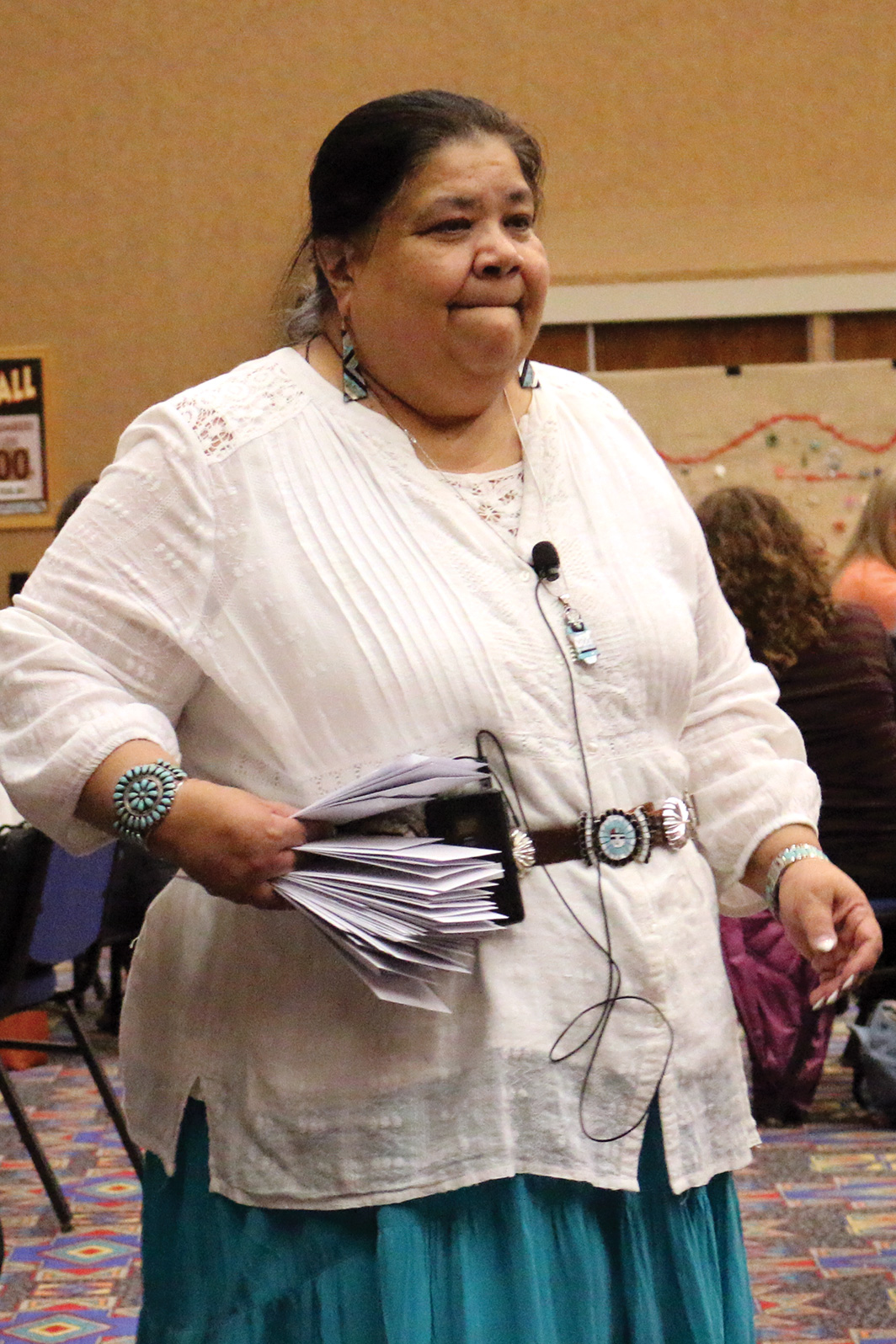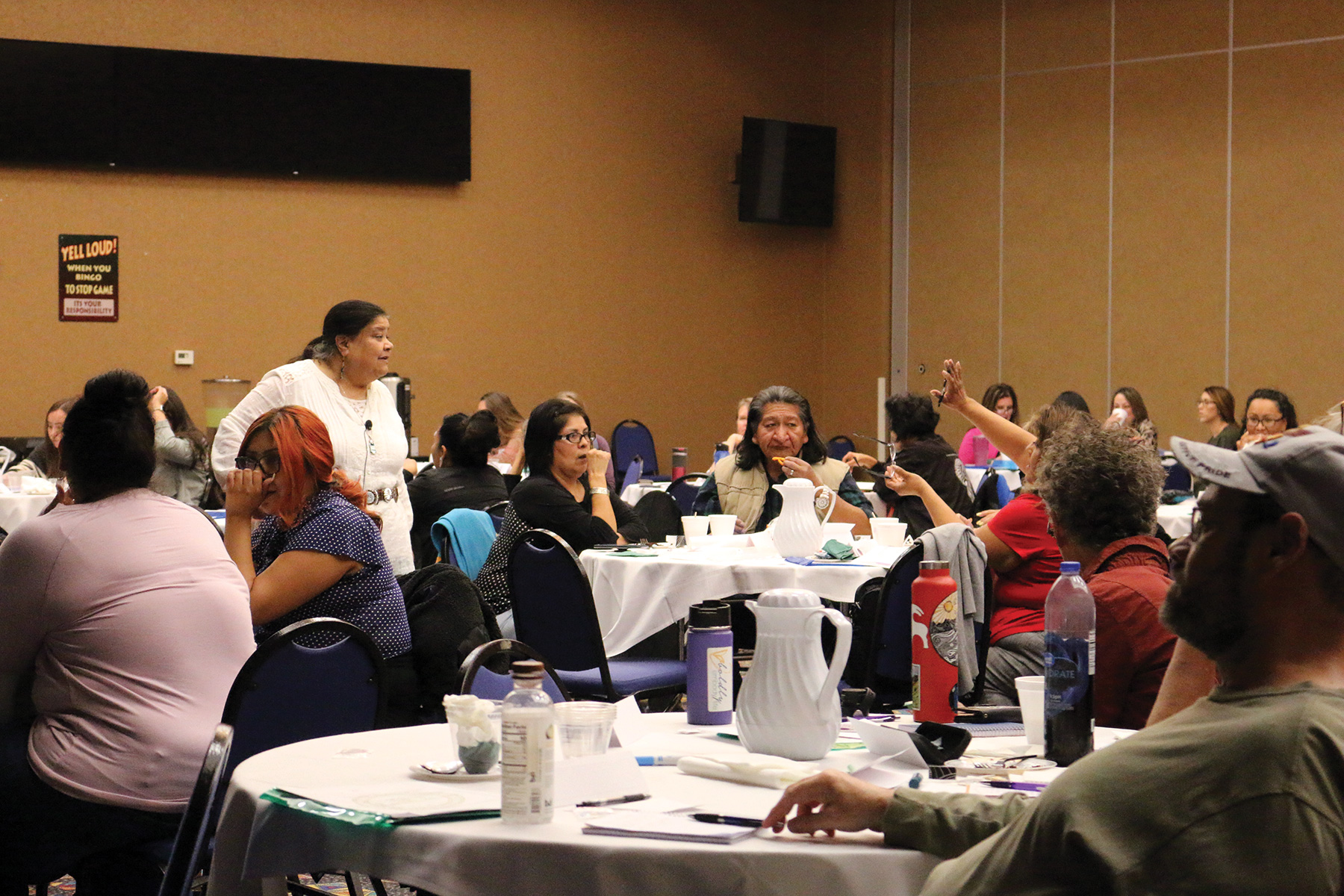The Ute Mountain Victim Support Services hosted a Historical Trauma Training at the Ute Mountain Ute Casino March 10 -11. The training was presented by Elena Giacci, Anti-Sexual and Domestic Violence Training Specialist out of Albuquerque, N.M.
Giacci has been an advocate for American Indian and Alaskan Native peoples for 31 years and is the Chair of the Albuquerque Mayors Domestic and Sexual Violence Task Force and Faculty Leader of Native Project 2.0. Giacci, a Dinè woman, who herself has felt the forces of historical trauma and knows what it takes to try to understand this historical journey.
Giacci is not a stranger to this area, she was in Ignacio, Colo. in 2013 and gave the presentation, “Kindness,” to help individuals overcome historical trauma and now calls New Mexico her home.
“We can’t call it historical trauma when it’s still going on,” exclaimed Giacci. “Pretending it didn’t happen doesn’t mean it didn’t happen.”
Giacci is hoping to bring forward the past while trying to heal from injustice that is still going on in Indian Country.
“We are free to take care of ourselves in any way we want to,” Giacci explained.
This training really was about being able to look into the past and try to see the future with a brighter light. Things that were touched upon are: MMIW Movement, colonialism and conquest, Indian Child Welfare Act, how to be an advocate in today’s world and consent in our communities along with learning how to communicate your story.
“How do you feel? What can you share? What did you learn? How did you heal?” asked Giacci.
Before colonization, violence to Native American women was rare. Many tribes would handle these matters within their own communities and such punishments were given: shunning, banishment, loss of rights to fishing or hunting and even death. It was up to each tribe on how to protect and honor their women. Now our indigenous women are one of the most highly victimized groups in the world. According to the Indian Law Resource Center in the United States, violence against indigenous women has reached unprecedented levels on Tribal lands and in Alaska Native villages. More than four in five American Indian and Alaska Native women have experienced violence and more than one in two have experienced sexual violence.
Regardless of how far we as a society have come, American Indian women are still being unjustly disregarded. The lack of data on the amount of Missing and Murdered Indigenous Women is alarming. The U.S. Attorney’s Office in 2011 indicates that just under 37 percent of all Indian Country submissions for prosecutions were declined. That means that 1,041 of 2,840 of the cases that were submitted to the U.S. Attorney’s Office were not accepted and turned away for prosecution, leaving local and Tribal governments reeling for justice for these women within their own communities.
Still Tribal governments face discrepancies when it comes to jurisdiction within their own reservations. In 2003, the National Congress of American Indians (NCAI) started a Task Force on Violence Against Women, and then in 2005, the Violence Against Women Act (VAWA) created a long-awaited relationship between the American Indian Tribes and the United States, which expired in 2011. In 2013 President Obama signed the Violence Against Women Reauthorization Act which ended in 2018 and is now pending reauthorization under the current congress.
Still a major factor is, how does tribal jurisdiction effect non-Native perpetrators? When enacted, VAWA would allow Tribal governments and court systems to prosecute non-Native perpetrators in domestic violence cases. Without it being reauthorized, Tribal governments or court systems will have no power over those cases, leaving American Indians all over the United States vulnerable to the hand that abuses them.
With all this trauma that continually aggravates American Indians not only as tribes or people, but individuals, we must ask – what exactly happened in the American Indian history books?
Wikipedia explains historical trauma as a cumulative emotional harm of an individual or generation caused by a traumatic experience or event. Historical Trauma Response (HTR) refers to the manifestation of emotions and actions that stem from this perceived trauma.
When we as people think about historical trauma a lot of times, we think of the boarding school era. American History books often overlook other genocidal tactics that were used against Native peoples, but there are many other instances that constitute genocide against the American Indian people.
Involuntary sterilization was one tactic used by the U.S. Government; which over 25 percent of the Indigenous women of the U.S. were unknowingly or pressured to get sterilized or even have their babies taken away, unaware that they were even still alive, and given to predominantly white families.
Physical violence was also used against indigenous people as well. During the Sand Creek Massacre, conflict between the Cheyenne and Arapaho people by the United States Army occurred in November of 1864. It is estimated that 500 people from their tribe were killed, most of them women and children. The Sand Creek Massacre happened what is now the southeast part of Colorado.
Trail of Tears, American Indians being forced to relocate from their ancestral lands. The Indian Removal Act in 1830 was the start of this, leaving approximately 60,000 Southeastern Native Americans homeless and exposed to disease and starvation while heading to what we now call reservations in present day Oklahoma.
Long Walk of the Navajo also knows as the Long Walk of Bosque Redondo which happened in 1886, when the U.S. Federal Government attempted an “ethnic cleanse” of the Navajo people and forced them to walk from what is now Arizona to eastern New Mexico.
Closest to home was Meeker Massacre also known as “Ute War.” In Septmeber of 1879, Utes attacked an U.S. agency, ultimately killing Indian Agent Nathan Meeker along with his employees. U.S. Major Thomas Thornburgh and his troops were also killed, continuing the conflict. Resulting in the removal of Uncompahgre and White River Utes from Colorado and reduction of Southern Utes’ land holdings within Colorado.
“What we really have to do is reconnect people,” said Giacci. “How can we create a narrative for ourselves as communities and individuals.”
Overall, Giacci revealed hope for Indigenous people who are now finding hope of survival through traditional practices, group support, speaking out about their experiences and taking the time to heal and build up resiliency in their own way. To understand is to believe that we as a people can overcome all adverse effects the past has held over us.
“You have to look deeper, way below the anger, the hurt, the hate, the jealousy, the self-pity, way down deeper where the dreams lie, son. Find your dream. It’s the pursuit of the dream that heals you,” American Indian Olympic Gold Medalist, Billy Mills said.




